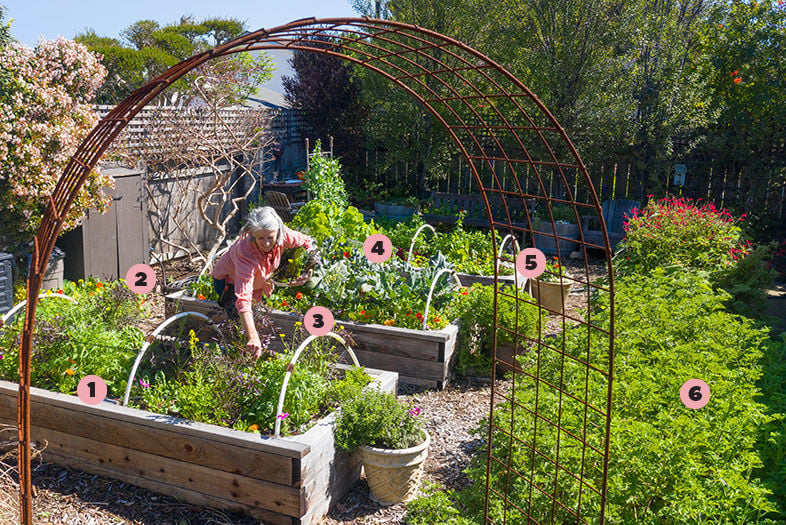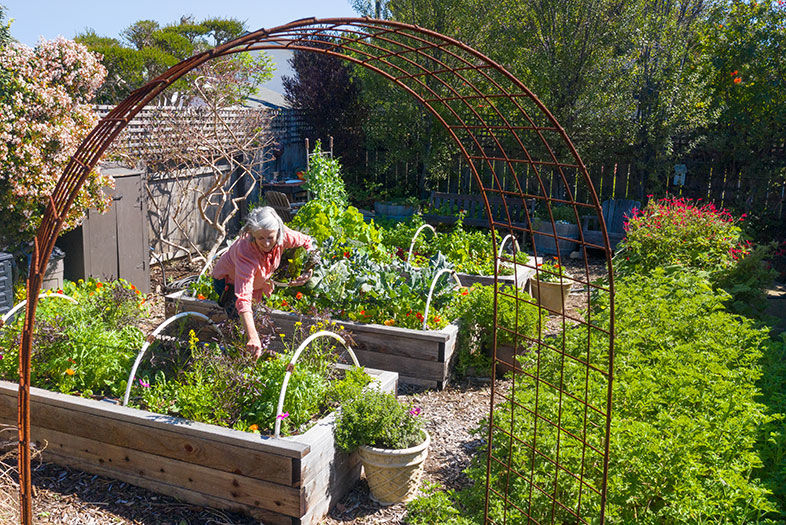
edible landscaping
Joni Gabriel tends to her edible garden in her University City backyard.
“I don’t like to go to the gym,” says Joni Gabriel, a retired educator and now University of California–certified Master Gardener. “I’ve had a YMCA membership for years. Sometimes I’ll get excited about it—ride the bikes, swim, do Zumba—and then it tapers off. But I’ll work like crazy in the garden. It’s my exercise and stress relief, a refuge.”
And today, the solace is just outside the back door of her University City abode, where she moved with her husband and son 17 years ago. “They don’t help at all with the gardening,” she jests. “They just enjoy the harvest.”
There’s a lemon tree, barrels of strawberries, and herbs on the perimeter of the 1,300-square-foot property, but her three raised beds (4 feet wide by 8 feet long and 18 inches deep) are the main show and reserved solely for annual fruits, vegetables, and edible flowers—the latter “bring in insects, and 99 percent of insects that come in your garden are beneficial.”
San Diego may have a year-round temperate climate, but she still adheres to the growing seasons, swapping winter crops like spinach, peas, and arugula for produce like squash, peppers, and tomatoes in the summer. Those tomatoes are the main reason she gardens. “There’s nothing like a tomato right off the vine. I can make ratatouille in the summer with my own squash, eggplant, tomatoes, and basil, all from my garden.”

edible landscaping
Key to the Garden
1. Netting
While the flowers attract good pests, the netting keeps out the bad ones from her raised beds: skunks, raccoons, and opossums that will eat her bounty.
2. Irrigation
Gabriel installed her own drip (underground) and emitter (aboveground) irrigation system, hooked up to a hose bib and complete with a battery-operated timer so different zones of the beds are watered accordingly. “I wanted it to be simple enough that I could go to Home Depot and get what I needed to fix it.”
3. Flowers
“As you can see, there’s lots of flowers. And all of them in the beds are edible. They look beautiful in salads. I interplant everything. Part of that is to confuse the insects. They might attack over here, so they leave this alone.”
4. Broccoli
As winter transitions to spring, vegetables like broccoli begin to “bolt,” Gabriel explains, meaning they lose flavor and start to flower—and attract beneficial insects. So, she keeps them in this state for a bit. Next year, she’ll plant a different crop here to keep the pests from taking hold of the soil. “It’s called integrative pest management.”
5. Seat
Gardens are dynamic, Gabriel says, and gardeners change with age. A few years ago, she raised her beds a few inches higher and had a friend build her a seat, so she wasn’t bending and paining her back.
6. Sensory garden
With the angle of the sun in mind, Gabriel planted a row of herbs that don’t mind shade along the side of her home. She deemed it her “sensory garden” for their unique smells and tastes, like rose geraniums, pineapple sage, and chocolate mint.
7. Sink
“It’s awesome to have a sink in the garden.” Hers is made from an old potting bench and sink from Habitat for Humanity ReStore, and simply hooked up to a hose bib.
PARTNER CONTENT
Learn more about Urban Gardening.

















